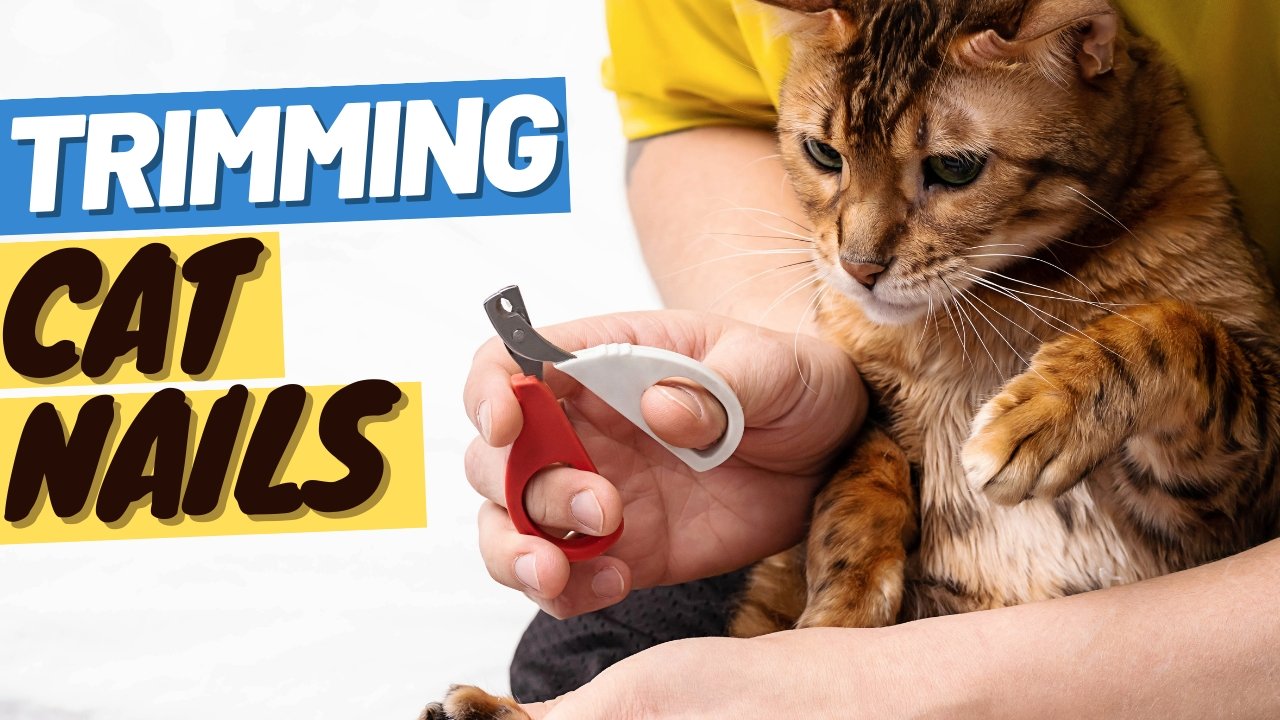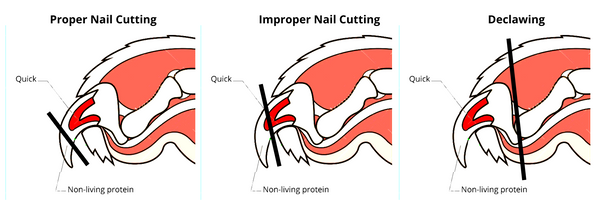Cats are notorious for their sharp claws and tend to scratch anything they come across. Living with a cat comes with compromises and what’s a natural behavior for our cat, might not be acceptable to us. While you can train your cat to leave your furniture alone, trimming their nails will also help protect your furniture if they were to scratch in a non-designated area.
This article aims to answer all the questions you may have about trimming a cat's nails and guide you through the process in a safe and stress-free manner.
Is it necessary to trim a cat's nails?
No, cats have their means to keep their nails healthy which include scratching. If you live in an apartment and you want to minimize scratching behavior, it is recommended to trim your cat's nails to prevent them from growing too long and becoming a source of scratching behavior.
Additionally, long nails can sometimes get caught in fabric or carpet, causing damage to the fabric or even injury to the cat.
Trimming your cat's nails will help you protect your furniture and keep your cat's paws healthy, but it's not needed and sometimes it's even not recommended. I don't trim my cat's nails and I'll share with you why later in this article.
Trimming your cat's nails is not declawing
It is important to note that trimming your cat's nails is not the same as declawing.
Declawing is a surgical procedure that removes the entire last bone of the cat's paw, which is painful and can cause behavioral and health problems. Trimming your cat's nails, on the other hand, only involves cutting the sharp tip of the nail and does not harm your pet.
What happens if you trim your cat's nails?
Trimming a cat's nails is more than just a grooming routine; it's a practice some cat owners swear by, while others prefer to let nature take its course. When you trim your cat's nails, you're not just reducing the risk of scratches to furniture or to yourself, but you're also preventing potential overgrowth that might lead to ingrown nails.
However, when not done correctly, trimming can be an unpleasant experience for the cat. Over-trimming can expose the sensitive part of their nail, causing pain and discomfort. Additionally, outdoor cats use their claws for self-defense and to climb.
While I do see the benefits of nail trimming, especially for indoor cats or those with a propensity for aggressive play, I also understand the concerns and hesitations some cat owners might have.
And that's why, in the next sections, I'll delve deeper into the pros and cons of this practice, and why I've made the choice I did for my feline friend.
Does it hurt cats to trim their nails?
Cats have nerve endings in their nails, called the quick, that can be painful if trimmed too closely (look at the above visual for reference). However, if done correctly, the process should not cause your pet any pain.
Some cats might find nail trimming discomforting or stressful, this will get better with time. Regular nail trims will also make your cat more comfortable with the process over time.
When should you not trim your cat's nails?
There are a few instances where you should not trim your cat's nails. If your cat has any bleeding disorders, it is best to consult a veterinarian before trimming their nails. Additionally, if your cat is elderly or has any joint problems, it may be difficult for them to extend their paws and cooperate with the trimming process. In these cases, it is best to consult a professional.
Finally, adventure cats should not get their nails trimmed
Cats that spend time outdoors and go on adventures with their owners should not have their nails trimmed as they rely on their sharp claws for survival in the wild.
They use their claws for hunting, climbing, and self-defense. While your cat might not need to hunt to survive, they might encounter dangers like dogs or other predators. Trimming a cat's nails can reduce their ability to perform these necessary activities, making them vulnerable to predators or other dangers.
It is important to allow adventure cats and outdoor cats to maintain their natural claws for their safety and well-being.
 What happens if you don't trim your cat's nails?
What happens if you don't trim your cat's nails?
If you do not trim your cat's nails, they can become overgrown and curved. This happens mostly when cats don't have the means to take care of their nails for themselves.
If this were to happen, you should take action and start trimming their nails, failing to do so can make it difficult for your pet to walk and cause them discomfort. Overgrown nails can also become embedded in soft tissues, causing injury and in some cases, infections.
In most cases, what will happen if you don't trim your cat's nails is that they are going to take care of them as they would in the wild, by scratching with their teeth and tongue. This might put stress if your furniture if you don't have designated areas for them to scratch. Damaged furniture is one of the reasons why people rehome their pets.
What's the easiest way to trim a cat's nails?
The easiest way to place the cat on your lap is while squeezing them between your elbow and chest.
- Grab one paw at a time. Once you have the paw, you can
- Gently press on their paw pads to expose the nails
- Slowly place the clipping nail in the desired length, making sure you don't cut more than needed, the quick is live tissue and it can hurt your cat and make them bleed. Once the placement is right,
- Clip the nail and reinforce and praise your cat
- Repeat this process for all the nails, and remember that you don't need to finish all 4 paws in one single sitting
 You must proceed slowly and calmly. It is best to start trimming your pet's nails from a young age, so they get used to the process.
You must proceed slowly and calmly. It is best to start trimming your pet's nails from a young age, so they get used to the process.
If your cat is not very comfortable with the process yet, begin by holding your cat gently and massaging their paw to get them comfortable.
Why do cats get mad when you trim their nails?
Cats may become nervous or agitated when their nails are trimmed. There are a few reasons that can trigger this:
- Novelty: Cats are prone to avoid new experiences and sensations as a means to avoid danger and preserve themselves.
- Past Experiences: Trimming the nails and cutting the quick by accident will cause pain to your cat. Your cat might associate nail trimming with that pain from an experience.
If your cat does not like getting their nails trimmed, it is important to create a positive and calm atmosphere while trimming your cat's nails, and to provide plenty of positive reinforcement and treats after the process.
I filmed a video of my last time trimming Mia's nails... she doesn't like it at all so I thought it would be good to share with you what to do when your cat doesn't like their nails trimmed.
How do I calm my cat before cutting their nails?
The best way to get your cat comfortable with nail trimming is with positive reinforcement. Give your cat plenty of treats after and during the process, and provide plenty of praise and petting after each nail is trimmed.
You can also try distracting your cat with toys, or using a calming pheromone spray to reduce their anxiety.
Finally, it is also a good idea to get your cat used to having their paws touched by gently massaging their paw pads several times a day, in the weeks leading up to the nail trim, so that they don't associate paw touching with nail trimming.
How often do cats need nails clipped?
As mentioned earlier in the article, it is not 100% required for cats to have their nails trimmed, but if you choose to do so, cats typically need their nails trimmed every two to four weeks, depending on how fast their nails grow.
If you're not sure how often your cat needs a nail trim, it's best to consult a veterinarian.
How can I tell when my cat's nails need to be trimmed?
You can tell when a cat's nails need to be trimmed when you can hear them clicking on hard surfaces when they walk. Another sign is if the nails have become so long that they are curling under and causing discomfort.
Inspect your cat's nails and take action before they become too long.
Which are the best nail clippers for cats?
There are many types of nail clippers available for cats, but it's best to use a pair specifically designed for small animals.
Some popular options include scissor clippers, guillotine clippers, and plier clippers. Whichever type you choose, it's important to make sure the clippers are sharp and easy to use.
If you are new at this, might be a good idea to have a styptic powder on hand in case you accidentally cut the quick, to stop any bleeding.
What should I do if I accidentally cut the quick?
If you accidentally cut the quick, which is the sensitive part of the nail that contains blood vessels and nerves, don't panic. Apply a styptic powder or cornstarch to the nail to stop the bleeding, and then hold a clean cloth or paper towel against the nail for a few minutes.
Can I use human nail clippers for my cat?
No, you should not use human nail clippers on your cat as they are not designed for the small size and thickness of a cat's nails. you can accidentally cut a big chunk of your cat's quickly hurting them beyond repair.
It is recommended to use a pair of clippers specifically designed for small animals, such as cats.
Are there any alternative methods for trimming a cat's nails, such as filing or using a nail grinder?
Filing or using a nail grinder can be an alternative method to trimming a cat's nails, as they can help file down the nail more slowly and smoothly, reducing the risk of cutting the quick. However, some cats may be scared of the sound of the grinder, so it is important to slowly acclimate them to the sound before using it.
How can I prevent my cat from scratching furniture after a nail trim?
To prevent your cat from scratching furniture after a nail trim, consider providing them with plenty of scratch posts and toys to redirect their scratching behavior.
Stop your cat from scratching furniture with our
Correcting Cat Behavior Articles
Stay wild, stay safe, and we'll see you outdoors!
Albert & Mia



0 comments